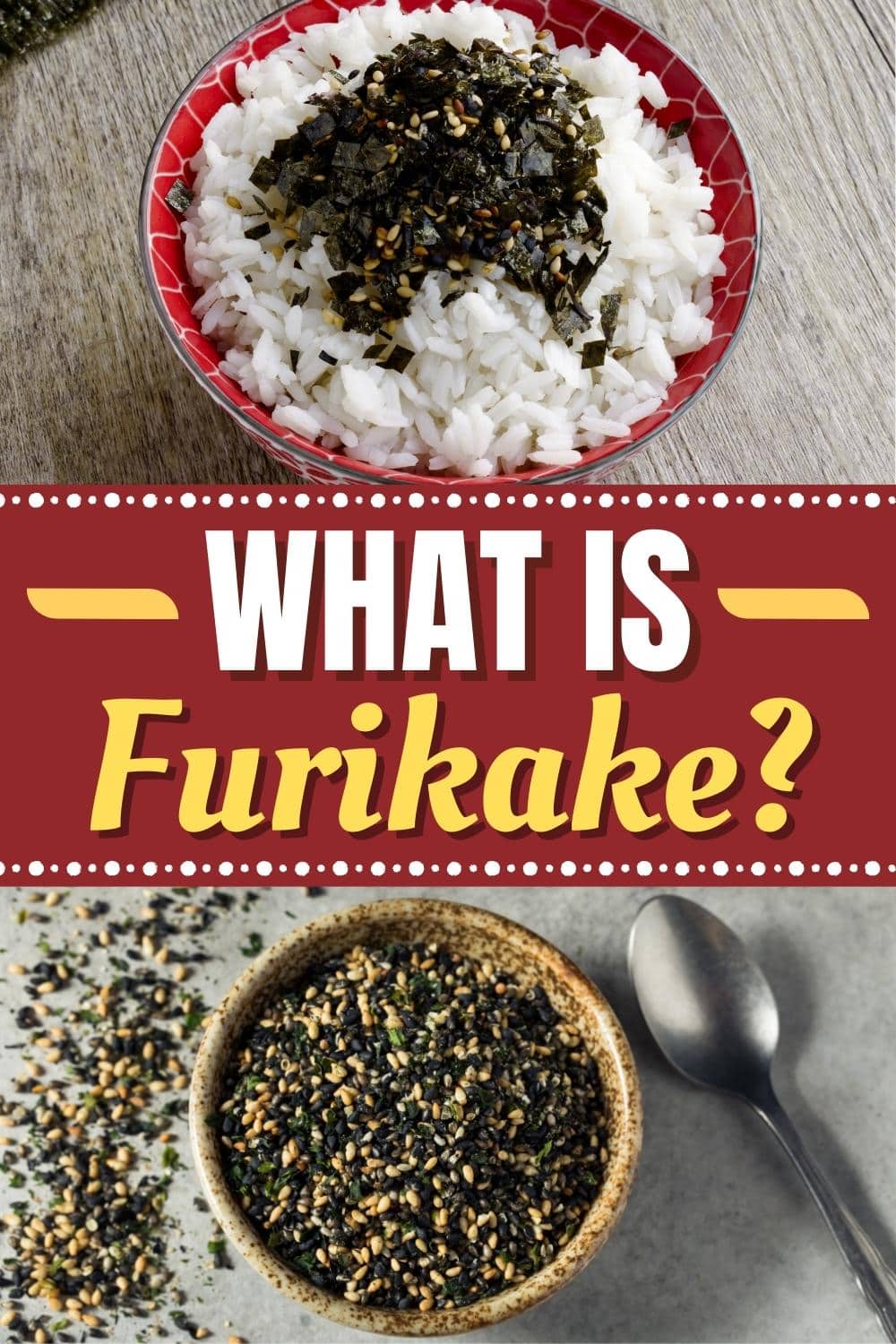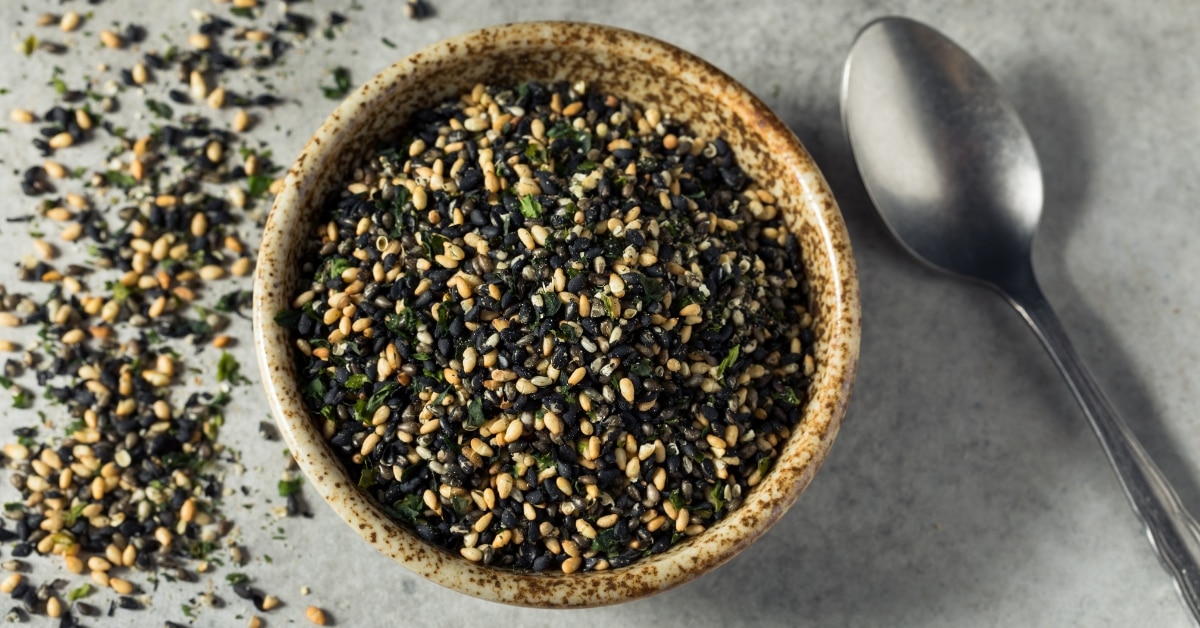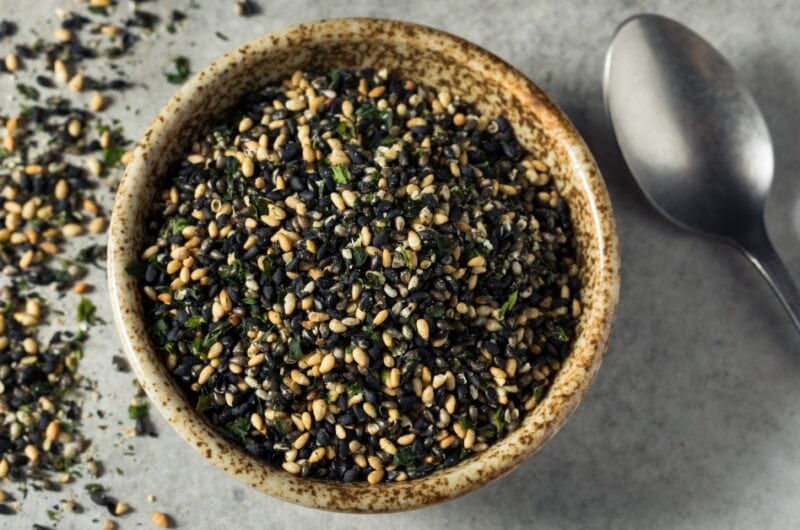Furikake is a Japanese seasoning blend typically sprinkled over rice. It can also enhance the flavor of many dishes.
It’s a mixture of dried ingredients such as sesame seeds, chopped seaweed, dried fish, sugar, salt, and savory seasonings.

This Japanese seasoning blend has been a staple in households across Japan for decades. But it’s also gaining popularity in the U.S. as people seek out new and exciting flavors to spice up their meals.
Let’s dive into exactly what furikake is and how to use it. It’s such an easy and convenient way to elevate your recipes!
What Is Furikake?
Furikake is a Japanese seasoning. It’s usually made from dried seaweed, sesame seeds, salt, and other ingredients. It adds flavor and texture to rice, vegetables, and fish dishes.
Common furikake varieties include bonito flakes, nori seaweed, and dried fish. Some furikake blends contain dried eggs, shrimp, or vegetables for added taste.
It’s often sprinkled over steamed rice or used as a topping for onigiri (rice balls). It can be sweet, savory, or spicy, depending on the ingredients used. Overall, it’s a convenient way to enhance the taste of meals.
The name “furikake” comes from the Japanese words “furi” (sprinkle) and “kakeru” (to pour).
It’s available in many flavors and can be found in Asian grocery stores or online.
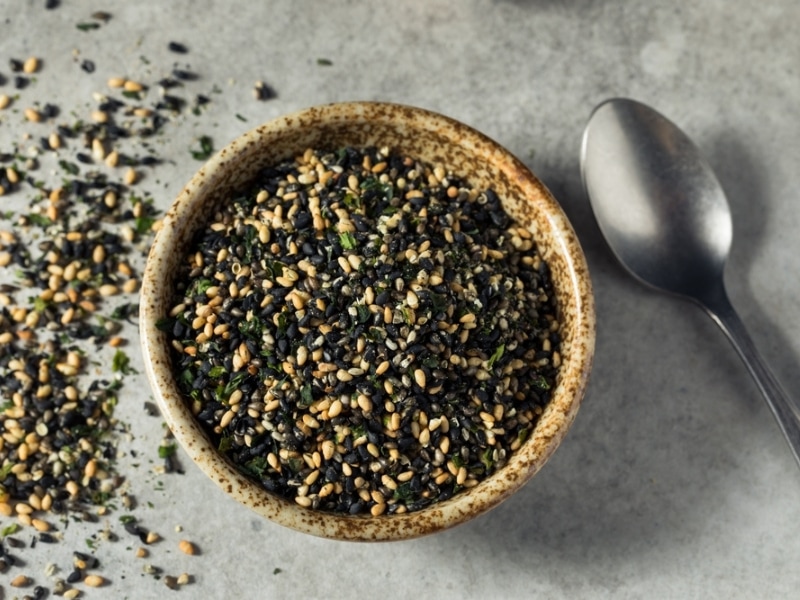
Furikake vs. Shichimi Togarashi
Furikake and shichimi are both popular Japanese seasonings, but they have distinct characteristics.
Furikake is a mixture of dried seaweed, sesame seeds, salt, and other ingredients, while shichimi is a blend of seven spices.
Shichimi is also known as seven-spice powder. It contains ingredients like chili pepper, orange peel, and sesame seeds.
Furikake is often used as a rice seasoning. Shichimi is commonly sprinkled on noodles, soups, or grilled meats.
Furikake offers a range of flavors, including umami, sweetness, or seafood notes, depending on the variety. Shichimi provides a spicy and aromatic kick to dishes.
Both seasonings add depth and complexity to Japanese cuisine and are enjoyed for their unique tastes. However, furikake is more versatile and can be used in a wider range of dishes.
Ultimately, the best choice depends on personal preference and the desired taste experience.
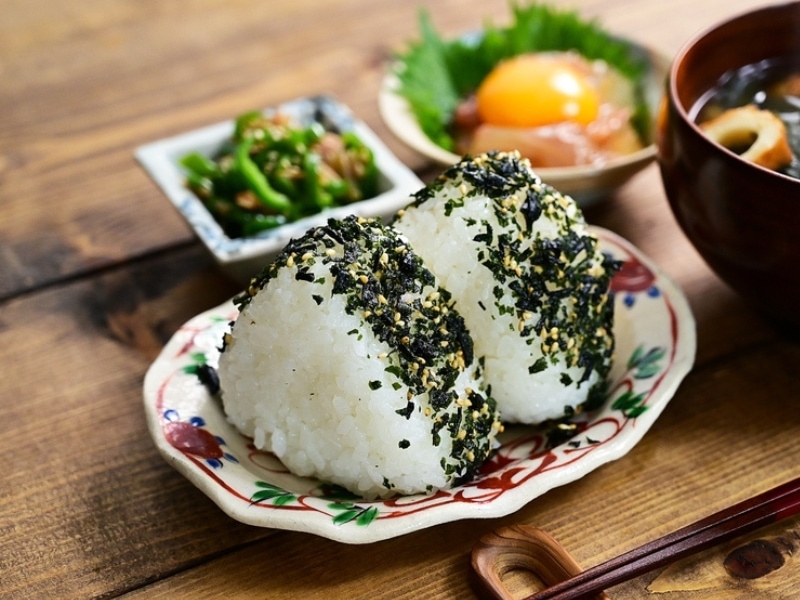
Ways to Use Furikake
- Rice enhancer: Sprinkle it over steamed rice to add a burst of flavor.
- Onigiri topping: Use it as a delicious topping for onigiri (rice balls).
- Veggie booster: Sprinkle it over roasted or grilled vegetables for added taste.
- Dip or sauce: Mix it into mayonnaise or yogurt for a flavorful dip or sauce.
- Snack seasoning: Sprinkle it over popcorn or roasted nuts for a tasty snack.
- Savory eggs: Try it on scrambled eggs or omelets for a savory twist.
- Breadcrumb upgrade: Mix it into breadcrumbs for an extra flavor kick in breaded dishes.
- Seafood seasoning: Use it as a seasoning for grilled or roasted fish and seafood.
- Avocado toast upgrade: Sprinkle it over avocado toast for a delightful flavor boost.
- Dressing or marinade: Mix it into salad dressings or marinades for a Japanese-inspired taste.
- Soup garnish: Use it as a topping for soups like miso soup or udon noodles.
- Anything else: As always, experiment and use it in other dishes.
How to Make Furikake
Step 1: Mix the sauces and aromatics
Begin by heating a frying pan over low heat. Pour in a mixture of soy sauce, mirin, sake, and sugar. Allow the liquid and sugar to warm up slowly. This ensures a gentle and even heat distribution.
Step 2: Saute Bonito flakes
Once the sugar has completely melted, introduce the bonito flakes to the pan. Start sautéing them while continuously stirring the mixture. Ensure the bonito flakes are evenly coated and cooked.
Step 3: Add sesame and seaweed
After the moisture has evaporated from the mixture, incorporate the sesame seeds and seaweed flakes. Gently combine them with the sautéed bonito flakes, using a gentle stirring motion. Be sure all the ingredients are thoroughly mixed for an even distribution of flavors.
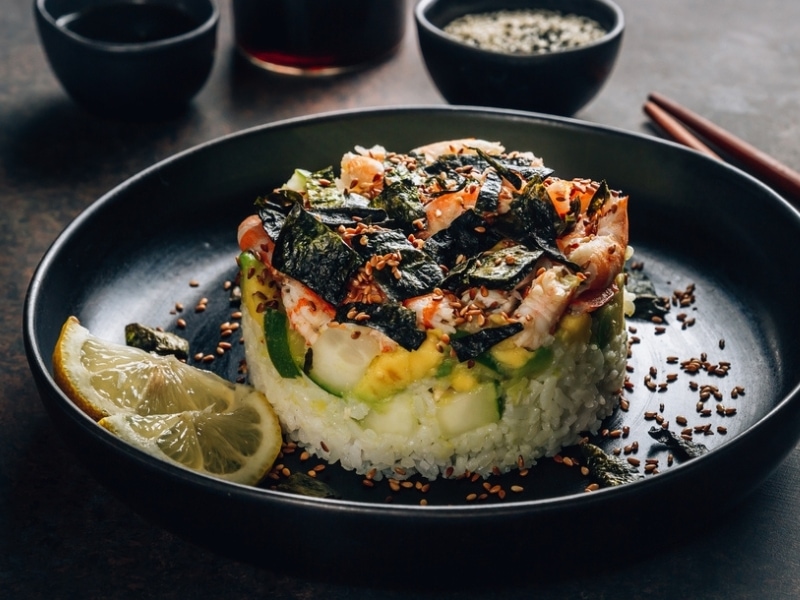
Types of Furikake
- Wasabi Furikake: This furikake contains a blend of dried seaweed, sesame seeds, salt, and wasabi. It has a spicy kick and a hint of heat.
- Shiso Furikake: Shiso furikake includes dried shiso leaves, sesame seeds, and other seasonings. It has a unique herbal and slightly minty taste.
- Salmon Furikake: Salmon furikake incorporates dried and powdered salmon flakes along with other seasonings. It adds a distinct seafood flavor to dishes.
- Gomashio Furikake: Gomashio furikake consists mainly of toasted sesame seeds and salt. It offers a rich nutty flavor and can be used as a versatile seasoning.
What Does Furikake Taste Like?
Furikake has a unique taste combining savory, umami, and slightly salty flavors. The blend of dried seaweed and sesame seeds provides a subtle nuttiness and oceanic essence.
Depending on the variety, furikake can have hints of sweetness and smokiness. The overall taste is rich, flavorful, and enhances the natural flavors of the dish it’s used on.
The sesame seeds contribute a pleasant crunch, while the seaweed adds a delicate brininess.

Where to Buy Furikake
- Asian grocery stores: Look for a dedicated section for Japanese or Asian products.
- Online retailers: Websites like Amazon, Walmart, or specialty Japanese food stores offer a wide selection of furikake.
- Japanese markets: Check if there are any local Japanese markets or specialty stores in your area.
- International food sections: Some larger supermarkets or gourmet stores have an international aisle where furikake may be available.
- Online Japanese food stores: There are online stores specifically focused on Japanese products that offer furikake.
- Asian food festivals or events: Attend local cultural festivals or events that celebrate Asian cuisine, where furikake might be sold.
How to Store
- Seal it tightly: Ensure the furikake container or packaging is properly sealed to prevent air and moisture from entering.
- Store in a cool, dry place: Keep it in a cool and dry pantry or cupboard away from direct sunlight and heat sources.
- Avoid humidity: Moisture can cause it to clump or lose its texture. So be sure the storage area is free from excessive humidity.
- Use an airtight container: If the original packaging is not resealable, transfer the furikake to an airtight container or jar.
Label the container: Clearly label the container with the type of furikake and the date. This will help track its freshness.
